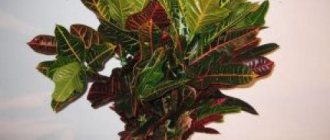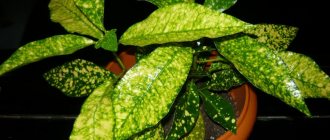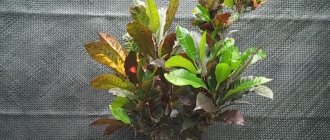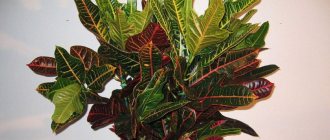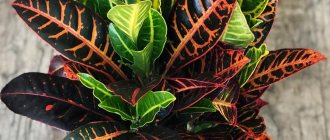Author: Elena N. https://floristics.info/ru/index.php?option=com_contact&view=contact&id=19 Category: Houseplants Published: January 03, 2019Last edits: January 11, 2021
- Growing from seeds
- Croton dropped its leaves
- Croton variegated (variegatum)
Croton (or codieus) is the most beautiful representative of indoor decorative foliage plants. Its dense glossy leaves amaze with the variety of shapes and colors in the autumn palette. The seeds of crotons growing in nature are used to obtain medicinal oil, and valuable resins are extracted from some species.
The cultivated croton is a terrible sissy, constantly demanding love and attention. But this elegant bush is so charming that you will readily forgive all its whims, especially since from our article you can find out:
- what conditions does croton need;
- what care will make the plant look as attractive as possible;
- how to protect croton from diseases, pests and other problems.
Planting and caring for croton
- Flowering: the plant is classified as an ornamental deciduous plant.
- Lighting: bright sunlight before noon, and then bright diffused light or light partial shade.
- Temperature: in summer 20-22 ˚C, in winter not lower than 16 ˚C.
- Watering: constant but moderate.
- Humidity: high. The plant needs constant spraying and washing of the leaves, as well as regular shower procedures (once or twice a month).
- Feeding: with a solution of complex mineral fertilizer for decorative deciduous plants twice a month from April to November, the rest of the time - once a month.
- Dormant period: winter.
- Transplantation: young plants - 2 times a year, adults - 1 time every two years.
- Reproduction: seeds, leaf and stem cuttings.
- Pests: mealybugs, scale insects, nematodes, spider mites.
- Diseases: sooty fungus, gray rot,
- Properties: the juice of the plant is poisonous.
Read more about growing croton below.
plant (lat. Croton) , also known as codiaeum (lat. Codiaeum) or “Joseph’s cloak ,” belongs to the genus of the Euphorbiaceae family. Nobody knows for sure what the name “croton” means, which gardeners liked more than the scientific “codiaum”, translated from Greek meaning “head”. Maybe this name comes from the name of a city in southern Italy, where Pythagoras once founded his school, or maybe in some dialect this word means “shrub”... The homeland of wild crotons are the islands of the Pacific Ocean and Northern Australia, India, as well as Southeast Asia.
The number of species in the genus varies from 17 to 1200, but in indoor culture croton flowers are represented only by variegated croton and its hybrids. The croton flower is one of the most beautiful decorative foliage indoor plants, which serves as an excellent interior decoration and, as a rule, does not take up too much space. In some countries, the croton houseplant is considered the guardian of the hearth, protecting the house from bad energy.
- Description of amaryllis flowering
Decorativeness
Croton was brought to Europe in the mid-19th century , and for a long time it was a greenhouse plant, diversifying the artificially created tropics with its bright, variegated leaves.
Then, more and more often, croton began to appear in rooms, spreading throughout all European countries. Not all types of croton (codeum) have become widespread in home floriculture Naturally, species that grew up to two meters remained plants for greenhouses.
Preference was given to bright, variegated, medium-sized plants with leaves of interesting shapes. Based on these species, breeders developed crotons with even more bizarre colors and unexpected leaf shapes.
The following types of croton are extremely popular: Motley, Excellent, Petra, Tamara.
Features of cultivation
The indoor croton flower is a bush with leathery leaves of various shapes: asymmetrical, oblong-lanceolate, pointed or blunt-pointed, entire-edged, three-lobed, notched, broadly ovate, etc. Young leaves, usually lighter shades of yellow-green, become richer green and burgundy colors over time, so your indoor croton flower is colored like an elegant autumn forest. A common feature for leaves of all varieties and varieties is pronounced venation. The flowering of croton will not cause you any delight, since it is a pendulous axillary racemose inflorescence of inconspicuous cream flowers.
In the photo: Croton growing outdoors
The home flower croton has earned the reputation of one of the most capricious plants. What are the features of caring for croton?
- Croton juice is poisonous. It causes diarrhea, vomiting, and contact dermatitis, so all work with croton should be done with gloves.
- Croton at home requires not only spraying the leaves with a spray bottle, but also wiping them with a damp sponge. In the summer, give your croton a warm shower every month.
- Croton does not tolerate watering with cold water and drafts!
- Sometimes at the beginning of the growing season, croton leaves take on strange shapes. No one knows how this is explained, but croton has a high degree of mutation, which is why it has become possible to develop many varieties and hybrid forms of this plant, and they differ only in how the leaf of one or another variety of croton looks.
- The inconspicuous flowering of croton takes a lot of energy from the plant, and if you are not going to engage in breeding experiments, it is better to remove flower buds or peduncles immediately.
Description of the plant
Variegated codiaeum (codiaeum variegatum) is often also called Croton Variegatum. Only this one species of the entire genus has been adapted as a houseplant. And on its basis, all existing cultivated varieties of codiaum were bred.
Externally, the culture resembles an upright shrub or tree. In room conditions it can grow up to 150–200 cm.
The stem is thin, branching, with leathery leaves with a distinct central vein. The color of the crown is usually different shades of green, yellow or red, but there are varieties of the plant with a white or black crown.
There are many varieties of Codiaum variegatum, mainly classified by the appearance of Codiaum (Croton) variegated.
Croton care at home
Rules of care
Croton loves bright light, but can only take baths in direct sunlight in the morning or before sunset, so in the summer, a northern window sill is suitable for it, and in winter, when the sun shines but does not warm, a southern one is suitable. If you have the opportunity to take your croton out into the fresh air and bright, indirect light in the summer, do not neglect it. The most comfortable temperature for croton in summer is 20-22 ºC, in winter – not lower than 16 ºC.
In the photo: Handsome Croton
Croton needs watering so that the earthen ball is slightly moist all the time, but at the same time, so that the moisture does not stagnate in the roots and does not cause the risk of their rotting. Water for irrigation should not be cold, and most importantly, it must be filtered or at least settled. Air humidity is of great importance for croton, so you will have to regularly spray or wipe the leaves with a damp washcloth, and in the summer, give it a warm shower once a month, but so that water does not flow into the pot.
How not to ruin zamioculcas - advice from experienced gardeners
Croton is fertilized with a solution of complex mineral fertilizers on pre-moistened soil from April to November twice a month; in winter, once a month is enough. To form a beautiful crown in croton, pruning (for an adult plant) and pinching (for young crotons) is used. Plants that have reached 15 cm in height are pinched, and then each time the shoots grow 20 cm. In adult plants, after pruning, the sections are treated with sulfur or charcoal powder.
- How to treat and fertilize roses in August, do they need to be pruned?
It is advisable to remove the emerging flower buds or young flower stalks, because flowering, which has no decorative value, exhausts the croton, and this affects the health and beauty of its leaves.
In the photo: Growing croton in a pot
Transfer
Young crotons are replanted twice a year, mature ones - once every two years, and each subsequent pot should be 2 cm in diameter larger than the previous one. When your croton occupies a container with a diameter of 25 cm, this will be its last replanting, but after that you will have to annually remove the top layer of soil from the pot and replace it with fresh substrate. The soil for croton should be approximately the following composition: turf, peat, leaf soil and river sand in equal parts.
When replanting, it is advisable not to disturb the croton earthen ball, but simply transfer it from the old pot into a new container with a drainage layer of about a quarter of the pot’s volume.
Croton in winter
When the cold season comes, the croton is moved from the northern window sill to the southern one, watering is reduced, but they continue to adhere to the same principle: the earthen ball should be slightly moist. Water procedures are also continued - spraying and wiping the leaves with a damp sponge, but this is not done as often as in the warm season, and it is better to forget about the shower until the summer. The plant needs to be fed no more than once a month, but some professionals are confident that in winter croton does not need feeding at all.
In the photo: Yellow croton leaves
Distribution history
Croton's homeland is the tropics and subtropics. In fact, the homeland of this plant depends directly on the variety. So, for example, the country of origin of the dragon croton is America. But another representative - laxative - “lives” in Asia. Thus, these plants are scattered throughout the world, in those regions where weather conditions are favorable for their growth.
Despite the fact that this representative of the flora grows only in certain regions, it is widely used throughout the world. For its seeds, it is bred in India, the Philippines, Ceylon and the Sunda Islands, from where it is imported to European countries. This flower became famous around the 19th century.
At the moment, breeders from the USA are also very interested in obtaining new varieties of this plant, and are conducting experiments in the selection and development of new varieties.
Croton propagation
Growing from seeds
At home, croton is propagated by seeds, when it comes to growing hybrids, and by stem or leaf cuttings. Croton seeds quickly lose their viability, so you need to sow freshly harvested seeds. It should also be taken into account that the germination process takes a lot of time, and most importantly, that varietal characteristics are usually not preserved during generative propagation. Before planting, large croton seeds should be heated for half an hour in water at a temperature of 60 ºC and left for a day to swell. Sowing is carried out at a depth of one centimeter, the temperature required for seed germination is 22 ºC. Until the seedlings appear, the soil in the container with the seeds is moistened with bottom watering. When the seedlings have their third leaf, they are planted in separate pots with a diameter of 7 cm and cared for like an adult croton.
In the photo: Growing croton
Vegetative method of propagation
How to propagate croton by cuttings? The easiest way to root is an apical cutting 6-10 cm long, but if you need several cuttings, then the shoot is cut into pieces so that each segment has at least one internode with one healthy leaf. Lignified or semi-lignified cuttings take root most easily.
The poisonous milky sap that flows from the sections should be washed off with water, and then the sections should be allowed to air dry for three hours.
- Cymbidium at home, photo
On the upper part of the apical cutting, the leaves are shortened parallel to the veins by half, and the leaves are removed from the lower part. Then the cuttings are placed, dried and root-treated, into a container with water heated to 23-30 ºC (to avoid rotting of the planting material), and placed under bright, diffused light to grow roots. When the cutting grows roots 2 cm long, it is transplanted into a croton substrate. In the first decade after transplantation, it is necessary to create increased air humidity around the cuttings transplanted into the ground through frequent spraying. You will know that the cuttings have begun to grow when the elasticity of the leaf is restored.
How to propagate
For all its capriciousness, croton is very easily propagated by rooting cuttings. The seed method of obtaining new plants is used a little less frequently.
Cuttings
For rooting, it is best to use not young shoots, but older branches that are partially (but not completely) woody, since they are less susceptible to rotting.
The process looks like this:
- You need to cut the cuttings at a right angle at a height of 10–15 cm from the top. There should be from one to three buds on the shoot.
- The lower leaves from the shoot should be cut off, and the milky juice released from the wounds should be thoroughly washed off. The remaining leaves, if they are large, can be carefully rolled into a tube and tied to better conserve moisture.
- Then it is advisable to keep the cuttings for 24 hours in a solution with activated carbon or a growth stimulant (preparations such as “Kornevin”, “Heteroauxin”, “Radifarma”, “Charkora”).
- After this, the shoot is placed in a mixture of sand and peat and placed in an improvised greenhouse for rooting. The place for rooting should not be very light, but warm enough (+23...+25 ºC), and it is desirable that the heat source is not from above, but from below, so the easiest way is to install the container with cuttings on the windowsill near the radiator.
Further care for the cuttings, which lasts from one to one and a half months, consists of regular ventilation and spraying, and it is recommended to add aloe juice to the water as a stimulant. When the young plants send out new shoots, they are immediately transplanted into separate pots with the usual soil mixture for croton.
Seeds
Before planting, codiaum seeds should be placed in hot water for 30 minutes, and then soaked for 24 hours in water with the addition of growth stimulants.
Then proceed as follows:
- The seeds are laid on the surface of a previously prepared substrate (sand and peat) and sprinkled on top with a thin layer of the same mixture up to 10 mm. The container is covered with film and placed in conditions similar to those described above for rooting cuttings. Shoots should appear in about two weeks.
- After this, you need to start removing the film, first for a short time, then this period gradually increases so that the growing shoots gradually get used to the open air.
- After removing the film, the sprouts are watered and sprayed, and when they form three true leaves, they are transplanted into separate pots.
Important! The seed method of propagation of codiaum, unlike the vegetative method, does not guarantee the preservation of maternal characteristics in the new plant. This problem is relevant for all hybrid forms.
The absence of brightly colored leaves on young plants does not indicate a loss of decorative qualities of croton: this is the peculiarity of this flower; unusual shades of its foliage appear with age, and this happens most recently with pink and red flowers.
Pests and diseases
Croton is affected by mealybugs, nematodes, scale insects and spider mites, and most often by mites. It is difficult to say why croton attracts them so much, but sometimes fighting with them brings the owner of the flower to an extreme degree of irritation, and he, despairing of winning this fight, simply throws out the croton. But let me remind you: if you follow all the rules of care, your plants are not afraid of either insects or diseases, and the appearance of mites is explained by the fact that the croton was rarely washed and watered irregularly, so you only have yourself to blame for this kind of trouble.
You can fight spider mites, scale insects and scale insects by wiping the ground parts of the croton with a tobacco solution with added soap, which must be washed off after an hour and a half so that it does not get into the substrate.
In the photo: Healthy croton
Croton dropped its leaves
If the plant has dropped its leaves, it means it cannot drink. This happens if the roots are cold. Move the plant to a warm, bright place, adjust the moisture regime, allowing the earthen clod to dry a few centimeters deep between waterings, stop feeding the flower, spray the leaves well and put a transparent bag or cap on the plant.
All about azaleas in questions and answers
Why does croton dry out?
If only the lower leaves of a croton dry, then there is no need to worry: the gradual exposure of the lower part of the stem is a natural process for crotons. Dry tips of the leaves indicate that the plant suffers from low air humidity, and for croton a comfortable humidity level of 70% is comfortable. If the edges of the leaves dry out and brown spots appear on them, it means that the room is not warm enough and the croton is freezing.
If the croton's leaves not only dry out, but also fall off, then its roots definitely do not have enough moisture.
In the photo: A rare variety of croton
Why does it drop leaves?
Often readers of the site ask the question why croton leaves fall. We have already mentioned the first two reasons - chronically insufficient watering and low air humidity. This also happens when the room temperature is too low, as well as from temperature fluctuations or drafts.
What to do if croton leaves fall off?
- First, carefully re-read the rules for caring for croton.
- Secondly, analyze where and in what ways you violated these rules.
- Thirdly, correct your mistakes and prevent them from happening again.
The role of light.
Almost any of our articles contains the topic of coverage. After all, light is essentially the nutrition of plants, which means its role can hardly be overestimated. To improve the absorption of light energy, the plant saturates the foliage with chlorophyll. Accordingly, green color begins to predominate. If, on the contrary, there is more light than necessary, then the flower reduces the amount of chlorophyll. These processes can be noticed not only in crotons or other variegated plants. Flowers with regular green leaf color react in a similar way. Their foliage turns pale in the sun and acquires a yellowish tint.
Types and varieties
In indoor culture, variegated croton is grown, the distinctive feature of which is the ability to change the color and shape of the leaves depending on living conditions. It was this quality that made the species the basis for experiments in selection, which culminated in the development of many varieties, hybrid forms and varieties.
In the photo: Croton variegated (variegatum)
Croton variegated (variegatum)
grows in nature in Pakistan and China, sometimes reaching three meters in height. The leaves are short-petioled. The color of the leaves is green and brown. This species has several forms, differing in the shape of the leaves: adventitious, lobed, flat-leaved and decorated, which served as the basis for the development of many remarkable varieties.
Varieties:
- Mrs. Eyeston - grows as a large tree or bush with leaves brightly colored dark burgundy with bright pink spots, although there is a variety with golden leaves with almost black fragments and a variety in yellow-pink tones;
- Petra - in nature it grows to a height of up to four meters, branches well, the shape of the leaves is oval, lobed or pointed, the color is dark green with a bright yellow edging and contrasting veins and specks of the same color;
- Black Prince - its wide oval flat leaves of black-green color with many yellow, red and orange spots look very exotic;
- Disraeli has lobed leaves, colored green at the top with yellow veins and specks, and brick-brown at the bottom;
- Excellent is distinguished primarily by the shape of the leaves, reminiscent of oak leaves; the color of the lower part of the leaf is red-burgundy, and the upper part is yellow-green.
The following varieties of variegated croton are also of interest: mollucian, minus, genuine, oval-leaved, tortoiseshell, curly and spiral. But no matter what type you purchase, you can believe that it will become the most noticeable decoration in your interior.
Multi-colored variety of croton varieties
Variegated codiaeum (Codiaeum variegatum), which we still like to call simply croton, even despite the considerable history of its use, is considered fashionable and modern. This unique variegated shrub came to Europe in the first half of the 19th century, and survived quite a serious selection that transformed the color palette of this amazing indoor plant into not just a representative, but also an impressive collection of varieties. Thanks to the breeding of varieties with leaves that differ in shape and a wide variety of colors, crotons allow you to select the appropriate variety for almost any decorative task. But at the same time, no matter what specific variety we are talking about, codiaum is always easily recognizable: it is a plant with a pronounced individuality.
The popularity of crotons is in no way diminished by their toxicity, which is characteristic of the crop to the same extent as other representatives of the Euphorbiaceae family, nor by the rather complex cultivation and care, which, although they are changing for the better in modern varieties, still do not allow the inclusion of codium to the list of hardy and unpretentious crops.
Cirrus crotons grow up to 35-100 cm in indoor conditions, depending on the variety. The shoots of the plant gradually become woody, very powerful, most often shortened. The leaves of codiaums are leathery, dense, glossy, with pronounced veins. The details of the foliage structure of different crotons are radically different. And the plant itself can change significantly with age. Young green-yellow leaves most often change color to a rich variety of variegated shades in adults. Moreover, this effect can be observed on any croton bush: at the bottom there are brighter large leaves, and at the top there are simpler, more delicate and younger ones.
In various crotons, the shape of the leaf blades is also fully manifested only with age. In almost all varieties and forms of croton, the veins on the leaves are colored in a light, whitish-yellowish tone. But all other varieties of codiaums can differ radically from each other. Croton has oval, lanceolate, divided into three lobes, wavy, dissected, curly, twisted and other types of bizarre leaves of irregular shape. Today, curly varieties with leaves twisted in a spiral are considered increasingly popular.
The division of crotons into different decorative forms and varieties is very arbitrary, since different flower centers sell the same plants under different names, sometimes croton forms are distributed as a variety or, conversely, some varieties have become so legendary that their names are considered almost separate species crotons, despite the fact that such plants are precisely varieties by origin. Thus, the codiaeum variety “Petra” is sold as Codiaeum petra instead of the formulation Codiaeum variegatum cv.Petra. Recognizing a croton variety and not making a mistake in choosing is not very easy based on appearance.
Young plants often do not display all the nuances of color; sometimes other plants are sold under the name of some varieties; individual cultivars are similar to each other and are easy to confuse. But, be that as it may, modern hybrid varieties or selective forms of variegated croton are distinguished by one very important characteristic - compact size, small, densely leafy bushes with enhanced color manifestation. These plants, unlike the old codiaums that only appeared in our homes in the last century, are much less capricious and more hardy. They lose only a few leaves over the winter, easily recover from one-time omissions of water procedures, although they require very careful care, they are still not so difficult to grow.
Young codiaums. © Frau-Doktor
Let's take a closer look at the best modern varieties of croton (codiaum) and individual forms that deserve our attention.
'Petra' is a unique variety of croton, today considered one of the most famous and frequently sold. This plant has large ovoid leaves up to 30 cm in length that form a compact, surprisingly ornamental crown. A distinctive feature of the variety is the dominance of only green and yellow colors and very thick veins located in the center of the leaf blade and extending from it as “ribs” with a notched edge. Only on very old croton leaves do the edges of the leaf blade and the central vein acquire a slight reddish tone.
'Sunny Star' is one of the most beautiful yellow-green croton varieties. The central yellow vein and uneven border along the leaves, sometimes covering most of the leaf blades on young leaves, coloring the crown with golden spots, are combined in this variety of codiaum with very thin and graceful numerous shoots and elongated tongue-shaped leaves with a wavy edge, which look very unusual.
'Norma' is one of the most beautiful long-leaved croton varieties. The densely arranged lanceolate, oval leaves, slightly reminiscent of rubber-bearing ficuses, seem very tough. Highlighted with yellow spots, and on older leaves with red veins, dark green leaves with uneven color changes look very graphic, festive and classic at the same time.
'Mrs. Iceton' is also a large-leaved croton variety with huge elliptical leaves with a stunningly beautiful glossy surface. The yellow-green young leaves of this codiaeum change to pink, red, orange or almost black-green; on some of them the spots are striking in their size. This croton's veins are usually dark in color. He also has his own hybrids - with a yellow or predominantly red color.
Codiaeum variegatum 'Petra'
Codiaeum variegatum 'Sunny Star'
'Bravo' is another very showy yellow-green croton variety. Young leaves are predominantly yellow, the color seems to spread from the veins throughout the entire leaf blade. But on the old leaves of this codiaum only thin luminous yellow veins remain, and the base color of the plates with a very dark rich tone seems to cover the entire plant. A light top with a dark bottom looks amazingly catchy together.
'Batik' with its amazingly picturesque leaves, as if painted by an artist, which combine almost black, bright green, red, orange, yellow and all imaginable shades of brown flowers in uneven and very picturesque spots, surprises with the similarity of the “speckles” with stains from paints. The color scheme of this croton variety combines dozens of different shades, with only 2 colors usually represented on each leaf.
'Baron J. De Rothschild' is a very beautiful multi-colored codiaum with young olive green leaves that change color to pink and orange. The veins of this codiaum are not yellow, but red, like the reverse side of the leaves, which makes it especially noble and spectacular.
'Gold Sun' is a very beautiful yellow-green variety of croton, in which young leaves are colored bright green, then become bright yellow, and then turn green again, only in a darker tone. The main feature of this codiaum is the small specks on the leaf blades, which slightly resemble the pattern of Dieffenbachia.
'Gold Star' is a narrow-leaved variety of croton, the leaves of which create peculiar rosettes or whorls, truly resembling voluminous stars in shape. The plant is decorated with uneven yellow specks that appear differently on old and young leaves. On this codiaum you can find almost completely yellow leaves, and dark green leaves only slightly highlighted with yellow dots.
Codiaeum variegatum 'Mrs. Iceton'. © ScotTi
Codiaeum variegatum 'Bravo'
'Black Prince' is a delightful flat-leaved croton variety with large elliptical leaves, the leaf blades of which are colored green and black and appear to be sprinkled with thin streams of yellow, orange and pink. This variety of codiaum also stands out in that it does not have pronounced colored veins.
'Gold finger' is one of the most original croton varieties. It was not called the “golden finger” by chance: the shape of perfectly straight, elongated, finger-shaped or tongue-shaped leaves really evokes such associations. The dark green color of this codiaum is combined with a very thick yellow uneven line or spot along the central vein and small yellow streaks that appear unevenly on the leaf blade. At a young age, this variety of croton seems like a continuous rosette of leaves; its shoots are shortened and take a long time to gain height.
'Yellow Snow' is an incomparable croton variety that looks like lemon paint has been splashed across it. The base color of the leaves is atypical for codiaums - quite light, almost light green. On old leaves, yellow spots cover almost the entire area of the blade; on young leaves they appear as yellow splashes. This variety is also distinguished by its increased bushiness, forms very dense bushes, the leaves are elliptical with a pointed tip, and medium-sized.
'Aucubofolia' is a beautiful codiaum with dark green oval-lanceolate leaf blades with strongly pointed tips, which develop in peculiar whorls. It got its name due to the similarity of patterns with aucuba leaves: small yellow dots appear unevenly against a dark background, the whole plant looks dusted with gold dust.
'Spirale' is a unique variety of croton, the leaves of which “look” almost vertically upward and are twisted along the central vein in a spiral. Green young leaves of codiaum gradually change color to almost red or ink red. The variety looks unusually impressive and is somewhat reminiscent of algae.
'Golden Bell' is a croton variety with elongated tongue-shaped leaves, which, due to a specific mutation, seem to be constricted and divided into several parts. The thing is that in the middle of the leaf the blades of the leaf plates or their lateral parts are interrupted, the central vein is exposed.
Codiaeum variegatum 'Gold Bell'
Codiaeum variegatum 'Mammy'
'Mammy' is a multi-colored, densely leafy variety of croton, in which you can admire the yellow-green colors of young leaves and the red-brown, and sometimes almost black, old leaves. The main feature of this variety of codiaum is the tongue-shaped or spatulate shape of the leaves and the twisting of the leaf plates, which are sometimes twisted so tightly that it is impossible to make out their shape.
'Holuffianaa' is a very beautiful and beloved variety of croton, the leaves of which are slightly reminiscent of oak, but upon closer examination it is obvious that only three blades stand out (more precisely, strong teeth along the edge form an oak-like strict shape of the leaf blades). Green with yellow veins, the young leaves of this codiaum completely change color to carmine red with pink veins - in adult plants.
'Excellent' is another oakleaf croton variety with a much more formal structure, most often producing a single central shoot. The large leaves on the plant are arranged in a tiled pattern. The green-yellow upper leaves of codiaum give way to red-burgundy, with light veins at the bottom of the crown.
Codiaeum variegatum 'Gold Star' & 'Petra'
